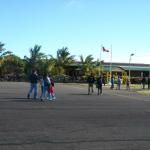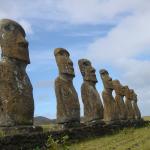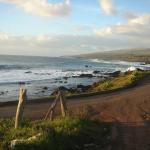© 2011 Sabrina Swenson. All Rights Reserved.
Easter Island
July, 2008
It is the most remote, inhabited island in the world; Easter Island or as the locals call it Rapa Nui! It is located in the South East Pacific and is a territory of Chile. It's 3,700 km (2,299 miles) from the mainland half way between Santiago, Chile and Tahiti. My fascination with this place came after seeing a documentary on the island. I was specifically impressed with the Moai (giant statues) scattered throughout it's land. The flight from Santiago, Chile on the mainland is 5 1/2 hours and as we were coming in for a landing on the island I kept looking out the window watching for land but didn't see any until we were just about to touch down. As you would imagine the airport isn't much more than a hut with a few amenities. In it's only town, Hanga Roa, I found a small B&B on a slight hill with a wonderful view of the ocean and village. The islanders speak Rapa Nui, Spanish and some English. Horses can be found grazing all over this island.
Rapa Nui was formed when the lava from three volcanoes in close proximity collided creating a single triangular land mass. It is 24km at it's longest and 12km at it's widest. All three of the major volcanoes are now extinct.
It is believed that the island was settled as early as the 4th or 5th century. The population grew over the centuries. Sheer numbers eventually threatened the available resources. Conflicts started between clans over the land and resources and by the 17th century war erupted. On Easter Sunday, 1722 a Dutch expedition under Admiral Jacob Roggeveen brought the first Europeans to Rapa Nui. Hence, it's modern day name. The island has endured it's share of cannibalism, epidemic, famine and slave raids throughout history. Since 1967 with the establishment of a regular commercial air service between the island and Tahiti and Santiago, Easter Island has been opened up to the world.
The island has a very barren landscape and trees are sparse as islanders cut the forests long ago. Most of today's trees, such as the eucalyptus were planted within the last century. The barren landscape adds to the eeriness of the Moai statues. The Moai (pronounced mo-eye) were carved out of compressed volcanic ash found inside the extinct volcano Rano Raraku. They were carved using stone hand chisels. A single Moai would take a team of 5 or 6 men approximately 1 year to complete. Each statue represents a deceased long-ear Chief or important person. Only a quarter of the statues were installed, while nearly half remain in the quarry at Rano Raraku. Anywhere from 180-250 men were required for pulling the statue into place depending on the size of the Moai. Each weighs as much as two elephants!
With it being winter in the Southern Hemisphere there were not many tourists on the island which made it ideal for exploring and taking pictures. The days were around 70 degrees and were perfect for hiking. The first day I hiked to the middle of the island to check out 7 Maoi statues in a row. The rest of my stay I rented a Jeep. I do believe this particular vehicle had no shocks or suspension! The road I mostly traveled went along the outer edge of the island along the ocean. It was not paved and was in serious need of repair. I bounced around every day on that road. My two favorite spots on the island were Ahu Tongariki with the 15 statues lined up on the beach and Rano Raraku "the nursery" which was located on the side of one of the volcanoes. I found that place especially odd as the statues there are partially buried and as a result of shifting they are all facing different directions and in different positions. At time's I was the only person there and I imagined how freaky it must be to be there at night in the dark with all these big heads everywhere! I also climbed inside the volcano one day and was greeted with a beautiful lake inside. There were also several older Moai statues scattered around the side. From the top of the volcano I could see most of the island. With the blue water and crashing waves; it was everything I thought it would be.
Easter Island is definitely a unique destination. The weather was perfect, the food excellent. As you would imagine seafood is abundant here. My favorite dish was ceviche; raw fish marinated in lemon juice served chilled with tomatoes and cilantro. I'll remember this very unusual trip for a long time to come!


























